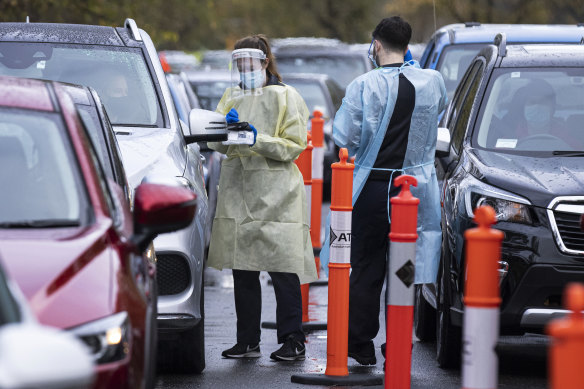- Exclusive
- National
- Coronavirus pandemic
This was published 3 years ago
South Australian COVID-19 leak likely a result of ventilation issue, experts say
The likely virus leak from a South Australian quarantine hotel that caused Victoria’s lockdown was caused by inadequate ventilation, experts insist, fuelling calls for more dedicated quarantine facilities and national standards for hotel quarantine.
The incident in early May is one of 19 serious leaks from Australia’s hotel quarantine system since the initial devastating Rydges and Stamford hotel outbreaks in 2020 that seeded Victoria’s second wave. The persistent breaches have so far led to eight lockdowns, including the recent Victorian shutdown as well as snap lockdowns in Perth in January and April.

Victoria’s shutdown was caused by an apparent leak in hotel quarantine in South Australia. Credit: Getty Images
“Medi-hotels (quarantine hotels) are not fit-for-purpose. We know that anyway, this simply confirms it,” said South Australian based epidemiologist Adrian Esterman.
”The reason why Howard Springs has been so successful is because it has these portable huts, with a big space between each hut, so there is virtually no way someone in one hut can expose someone in another hut.”
A Victorian man in his 30s from the suburb of Wollert is thought to have contracted the virus while quarantining at the Playford Hotel in Adelaide. The case has been genomically linked to the current Melbourne outbreak, which spread for days undetected and has pushed Victoria into a seven-day lockdown.
A report from the South Australian Government this week said the infection was probably due to the opening and closing of doors in the hotel corridor. It detailed two occasions on May 3 when an infected guest staying in the adjacent room opened his door shortly before the Wollert man. In one case there were 12 minutes between the door openings and on another occasion just 18 seconds, when the Victorian guest opened his door to collect his meal.
While the South Australia report found no apparent link to ventilation and coronavirus transmission, multiple experts who spoke to The Age and The Sydney Morning Herald say this claim is mind-boggling.
“It’s simply not true. There are problems with ventilation otherwise it couldn’t have spread,” said Professor Esterman.
Professor Jason Monty, head of mechanical engineering at the University of Melbourne, who has been advising Victorian officials on how to improve air quality in quarantine hotels, said there must have been air flowing from guests’ rooms into corridors.
“In my opinion, there has to be an additional push from the ventilation system,” he said.
Burnet Institute epidemiologist Mike Toole said it appeared to him that The Playford had either not been submitted to a proper ventilation audit before the leak, or the findings had not been acted upon.
He said it appeared, based on what was known of the case, that there was positive pressure pushing air from rooms to the corridor and not enough circulating air to get rid of the infection. The guests were located at the end of the corridor, which the South Australian report said may have “not have allowed exchange of fresh air to have occurred despite adequate ventilation levels in the corridor”.
But South Australia’s Chief Public Health Officer Nicola Spurrier said she didn’t think it was fair to call the suspected leak from South Australia hotel quarantine a “breach”.
“I think the term breach is a misnomer,” Professor Spurrier said. “We were doing the very best we could. We were following every protocol …. It has certainly been most likely that a transmission event has occurred in the hotel, but I think very clearly our investigation has shown that there has been no breach in protocol whatsoever.”
South Australia has closed its border to travellers from Victoria.
SA Health has refused to disclose whether there was a ventilation audit conducted at The Playford prior to the suspected leak, despite multiple requests. Queensland and NSW are currently in the process of assessing air flows within their quarantine hotels.
Experts say the South Australian case also highlights an apparent failure of the federal government to insist on national standards, or of some interstate authorities to learn from outbreaks elsewhere.
A spokeswoman for Health Minister Greg Hunt said the Australian government was “reviewing” arrangements for quarantine facilities and working with states and territories “on options to increase quarantine capacity”.
In February, a traveller at the Park Royal hotel in Melbourne is suspected to have contracted coronavirus from a family staying opposite, as doors were opened simultaneously to collect meals. Afterwards, staggered meal times and buffer rooms were introduced in Victorian facilities.
Three months later, a similar transmission seems to have occurred in South Australia, triggering a new outbreak and another report which found “a review of the timing and placement of food/goods/waste/linen outside of guests’ rooms is likely to reduce the risk of further episodes of similar transmission events”.
A SA Health spokeswoman said a quality improvement program was in place for the state’s hotel quarantine system “which incorporates relevant findings from other jurisdictions”.
“Changes were made across the medi-hotels in December 2020 to improve the ventilation in rooms and corridors, including ensuring all guest rooms have adequate door seals, fresh air intake, no shared air between rooms and ensuring that room exhaust fans are set to the optimal speed to reduce air turbulence.”
The Age and Herald contacted all states responsible for hotel quarantine on Friday to ask if they had conducted ventilation reports in their quarantine hotels. Western Australia has previously undertaken ventilation checks, though they were not acted on immediately.
Victoria has been pushing for the Commonwealth to support and fund their proposal to establish a cabin-style quarantine facility on the outskirts of Melbourne as an alternative to quarantine.